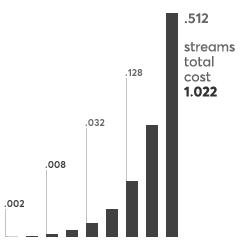This is obviously fundamental, just like Netflix stormed the world with their “first 3 months are free” we need to make it clear to people we’re giving them time to embrace the mechanism by themselves.
To come back to your example, I think “songs” isn’t a metric people are that used to (they know what a song is, they just don’t use it as a metric), so I’d rather say that since the “average length of songs on current streaming services is 3min17” that means on the average 3h (and 17 minutes lol) will set you back 5$ a month that means 10$ a month (the equivalent of a Spotify subscription) will give you 6h to 7h of music discovery everyday for a month, and if you just don’t listen to 6h every single day, it’s just that much more time you don’t have to spend for, that you get to use the next month.
But on a month to month basis the math would be this :
“The price of a monthly Spotify subscription gives you 6h a day of music discovery for 30 days and all of it goes to artists. The difference being you don’t pay when you don’t listen.”
Incidentally, this makes me think, (again I’m thinking out loud here, this would need to be precised) that we could split “pricing examples” into listening pattern categories for clarity like, “Discovery (the example I just gave)”, “Fans (there’s an album/artist you loved and listened to all month? > pricing is this and that)”, “Casual listeners (Only listen to music every now and then?)”
Whatever, try to find relatable scenarios and give them fair pricing explaining how and why those are exciting.
I think the “if you listened to this much then it’s this much” with tons of numbers and “0,18 x 30” etc. is still too disconnected we need to find ways so that people read a story and are “hey that sounds like me, looks like if I spend 10 bucks on this it’ll be good enough for a month or two”.
I know for example one scenario where we need to be frank because a lot of people can get obsessive over music they love, is like, “what if this month I loved an album and I listened to it all week?” because then this month you paid 10 or 15€ for that album, and you’re out of credits now, period. So there needs to be a scenario for those people (my guess would be to present them a scenario where either they click a “buy now” button so that this album doesn’t alter their discovery experience, or they just add a few dollars to manage discovery until the end of the month, but we need to imagine stuff like that because we need to ease them into this new and weird way to listen/buy).
I’m saying all this because let’s take an example : We offer people credit to find out what their listening pattern is, do we all agree that IS the idea behind behind the credits we offer? Well, what if their listening pattern is after 20 songs, they find an album that they just adore, and they listen to it ten times and it’s a 15 tracks album. Well then that’s over, they consumed the entirety of their credits (I actually think they used all of it long before they even “owned” the album). But they didn’t really have time to discover “their listening pattern” right? They just liked this one album.
The reality is if the number of credits we give away at the first login is too small, we’re not letting people discover their “listening pattern”, we’re pushing them to only play new tracks and avoid at all cost replaying them if they like them because they might consume the entirety of their free credits in one go.
The result is we’re effectively pushing them away from actually using S2O incremental pricings ! We’re telling them “only use this for discovery or pay already”.
So my workaround for this is :
- Increase free credits enough on entrance to have a “honeymoon” period where people can actually have fun with little to no pressure on our service.
- Create relatable “user pattern” stories and attitudes where we showcase what the service would be like in terms of spendings for various “archetypes” of listeners.
I think to find the archetypes I should start digging around for the various listening habits of people already on streaming platforms, how much do they listen to an album they just found out about, how much do they listen to their own playlists, how much time they spend discovering etc.
I’m already keen on having a “constent discovery all day” archetype, “spinning a few albums a lot” archetype, “casual listeners” archetype. And then we just tell the story we find when we crunch the numbers the way I did above.
PS: Right now if I’m correct we’re giving enough credits on sign up to discover 60 songs ? If so that’s no enough.



